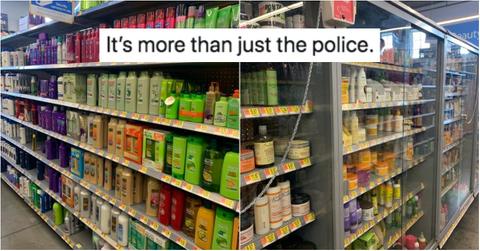Eye-opening examples of store racism that seem obvious once you see them
By Robin ZlotnickOct. 11 2024, Updated 4:51 p.m. ET
If you haven't noticed how widespread and deeply ingrained racism is in the United States, you might not have been paying attention. Racism isn't just a problem in police departments; it's present in our schools, our stores, and many other parts of society.
People have been sharing examples of subtle but deliberate racism in shops on X. The pictures show makeup for darker skin with extra security tags, styling products for Black hair locked up in glass cases, and products with Spanish labels that cost more than their otherwise identical English-language counterparts.
As Jesús writes, "It's more than just the police." A lot more. Why would stores lock up some products and not others? How can this be right?
Unfortunately, it's a common practice. In 2018, Teen Vogue reported that a Fred Meyer grocery store in Oregon "allegedly put hair care products for Black women behind a closed Plexiglass case while leaving other hair care products out."
Shopper Sade Rivers felt that this "played into painful, racist stereotypes about Black people." She decided not to have someone open the case for her because she was concerned that she might then be followed through the store.
The store, Fred Meyer, released a statement at the time saying that the extra security measure was based only on data. "At Fred Meyer, we periodically review items that require additional security measures. Decisions about product access in our stores are data-driven. We are a company that welcomes every customer who walks in our door. Additionally, we train our associates to embrace diversity and inclusion and want to show respect to every customer and one another," the statement read.
But if we step back for a second and think about where that data might come from, we understand that it's all intertwined. "Let's acknowledge that the issue is not the stores locking up high-theft products, but why those products are high-theft," one X user wrote. "They are frequently stolen because people can't afford them, right? Why can't people afford them?"
On a systemic level, people of color are not afforded the same opportunities as white people in the United States. There are higher levels of poverty in Black and minority communities by design. In fact, Black and minority communities only exist because white people have been fighting so hard (formally and informally, but just as insidiously) against integration for the entire history of the country.
Take, for example, this tweet about two identical pregnancy tests, but the one with the Spanish-language translations on the box costs 50 cents more than the English-language version: "Just an FYI y’all- if you’re looking for a pregnancy test at CVS, the ones with Spanish translation cost 50 cents more for no observable reason!!! I compared the boxes and the features and the only difference truly is the Spanish translation."
It's just another tiny, subtle way in which people of color are oppressed and discriminated against. Some people in the comments tried to both-sides this issue, saying the company must have needed to charge more for the translation work or the extra ink.
If that was your first thought, it might be time to consider the countless subtle ways in which people of color face discrimination, beyond the more obvious ones.
This article was originally published on June 15, 2020. It has since been updated.

